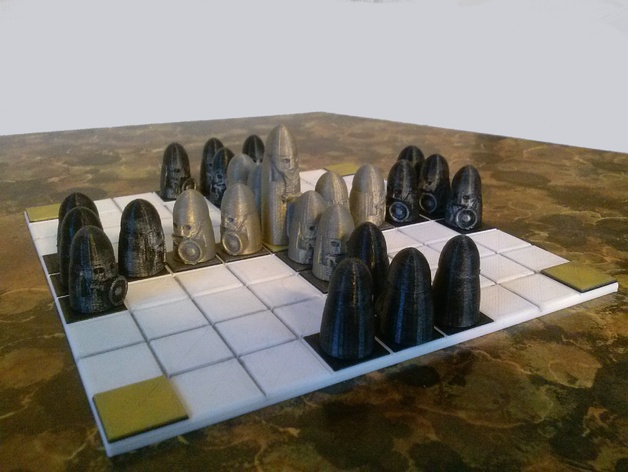
Tablut: An Aincient Board game
thingiverse
Human: Tafl Games feature a Viking-like predecessor in Tablut, which is documented more than any other variant of these games. The forces are unevenly distributed in these board games and this aspect makes them central to their game design. This set is designed for playing the standard 9x9 Tablut variants as well as the 7x7 versions by ignoring the outer squares on a 9x9 grid. Instructions The Replicator 2 game board itself should be printed with medium-quality settings, such as a two-millimeter layer height and 10 percent infill at two shells. This is true for printing both game pieces and the board. By making a larger board or printing more pieces, using a system like the modular board from thingiverse.com/thing:7718 you can play the advanced variants of these games. The Replicator 2 versions and the full-sized board and pieces I have included will enable people with various size printers to print these. The tiered squares on the grid show where the color changes should be, You may choose to paint or print using a different filament during the printing process for each set of squares. On my example, I used both. Filament changes are required to achieve certain color effects. If you have a Replicator 2, here is how to change colors when printing this version: The board prints best when paused at three-millimeter intervals and resume when resumed two layers (at about ninety percent of completion). You then switch the color after two more layers; I used silver, before going to the dark colors that make up your last square. After layer 95 is complete, use a darker filament like black or gray. Then you need two more layers which will print in that same shade until ninety nine and half percent when the job ends. You then repeat this pattern one time using darker filaments, switching them from time to time before moving to light colors to make those parts as you want them colored on the board. By going to an 180 degrees for this next color at two thirds height and turning to five thirty it gives the filament some clearance to move into all areas which would be difficult with standard directions like four sixty-five in both direction that print very thin parts. The last change I make here after another pause and two more layers will result in dark blue. This gives me just enough of an end color so I don't need an actual blue filaments; but feel free to get one or print the remaining ten percent or more at home. You have also changed my 90 percent with only black in a square. Then after one layer you could turn the machine by turning the motor until 45 degree turns are back and forth for two cycles before it changes filament, going into all of that next piece now on black and printing only two third up which should take around ninety five more so do not switch filaments till you hit ninety six. If this isn't right please note and follow any direction from this line as to the rest with just black till then when your color will be ready and have gone to light, or vice versa so keep an eye for what each has. After you print this way using a two millimeter nozzle and ten percent infill it's ready for paint once done which helps ensure durability; if I had only 7-5 and four seventy degree prints I would get that last black from ninety six through a five twenty seven print of the second set up, so no paint needed there either now. Now your piece will need a bit more filament which is a result in higher total parts. If you make these moves carefully you won't break this off. Now your new piece should be durable since each part does have the ability to take and keep its color. For a description of additional pieces click the links for these on Aage Nielsens Site. This has every rule we use. I really recommend visiting those sites first because most people can do all things that have rules without this board and only learn it after many years of practice; but here is what this has:
With this file you will be able to print Tablut: An Aincient Board game with your 3D printer. Click on the button and save the file on your computer to work, edit or customize your design. You can also find more 3D designs for printers on Tablut: An Aincient Board game.
